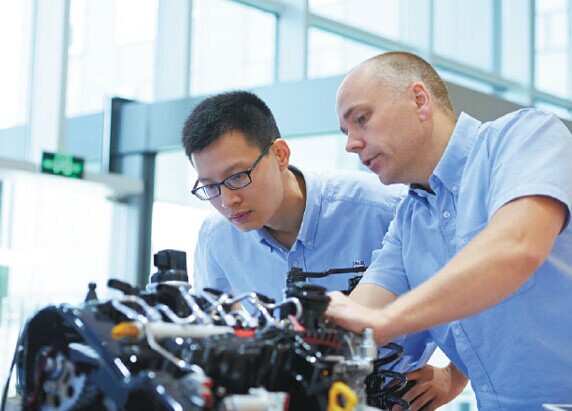

Employees at SKF Group's factory in Shanghai. The Swedish company operates 18 manufacturing units and several service units in China. Provided to China Daily
Shanghai unit to play key role in the sustainable growth plans of Swedish firm
While architects of the China (Shanghai) Pilot Free Trade Zone aim to catapult the city to the forefront of global financial, trade and logistics centers, they may never have expected to welcome a like-minded enterprise so soon.
On June 10, just months after the pilot zone took off, SKF Group, the world's largest ball bearing maker, launched its North East Asia Distribution Center in the Waigaoqiao bonded zone, an integral part of the FTZ.
The endeavor brought SKF's global chief executive officer Tom Johnstone to Shanghai to attend the inauguration.
"The move indicates the attraction of China market in terms of its strategic significance, as well as SKF's continued commitment to China," said Johnstone, who has spent 37 years with the Swedish firm and been at the helm of the company for more than a decade.
Before the establishment of the center, trade transactions by SKF in China were generally conducted in foreign currency by its Hong Kong subsidiary and logistics was largely handled by its Singapore unit.
Amid the global economic crisis in 2009, given SKF's development prospects in China, the company conducted a string of surveys before it decided to integrate and move such functions to the new Shanghai facility.
Johnstone said Asian business has expanded greatly and accounted for 24 percent of SKF's overall sales in 2013. The quick development of markets in northeast Asia area made it essential to split the logistics service in the Asia region into southern and northern parts to better serve customers. Both areas were previously served by SKF Singapore.
SKF North East Asia Distribution Center in Shanghai, set up at the start of 2013. It integrates logistic, trade and settlement functions and covers 47,275 square meters.
"Through the center, we aim to increase flexibility on stocking plans, reduce complexity of inventory structure arising from multi-currency transactions, and provide support for our global resource allocation and cost reduction," Johnstone said.
As in many business narratives, SKF's early presence in China followed the route of appointing an agent, setting up a sales company and, after decades of inactivity, resuming business and introducing manufacturing facilities following the launch of the reform and opening-up policy.
SKF makes products for around 40 industries, including automobiles, aerospace, wind energy, construction and industrial transmission. Its bearings are widely used in products ranging from household appliances to aircraft and helicopters.
SKF has also evolved from being a bearing maker to a bearing supplier. It is also present in sectors like lubrication, seals, mechatronics and services with its active mergers and acquisitions.
The company operates 18 manufacturing units and several service units in China. Primarily a business-to-business company, it delivers products, solutions and services to original equipment manufacturers and end-users.
"One of the priorities of Shanghai Free Trade Zone is to foster and develop Asia-Pacific operation centers and operational headquarters integrating logistic and settlement functions, which highly corresponds to the development goal of SKF North East Asia Distribution Center," said Dai Haibo, executive deputy director of Shanghai Free Trade Zone Management Committee.
According to Johnstone, the facility has already carried out some innovative trade and settlement measures with the support from Shanghai Free Trade Zone, including classified supervision by status of goods, strengthened function of delivering goods in batches, making centralized customs declaration, and opening international settlement accounts.
These greatly facilitated trade and contributed to the efficient and quick flow of funds.
"In a sense, the future development of SKF North East Asia Distribution Center will be the epitome of China's effort to strengthen its construction as a resource allocation hub in the global trade system," he said.
China accounts for more than 12 percent of SKF's global sales of 63.6 billion Swedish krona ($9.3 billion) in 2013.
While partly offset by the temporary cooling in the world's second-largest economy, growth still outpaced that of most other regions, Johnstone said.
Though economic uncertainty has seen some multinational companies winding down operations, SKF has never been hesitant about adding investment here.
Johnstone foresees the automobile, railway and renewable energy sectors enjoying growth.
To sustain its growth, SKF has put more resources into research and development and the country's automotive market by establishing a new SKF campus in Shanghai's suburban Jiading district to support growth in China and across Asia.
The 700 million krona-investment includes the setting up of a new automotive factory that produces hub-bearing units for passenger cars and also the relocation and expansion of the Global Technical Center China, SKF Solution Factory and SKF College.
The rationale of Johnstone is that the campus effectively integrates various SKF resources in product development, engineering, manufacturing, testing and training, which attract customers with more high value-added products and services.
Being in China on-and-off for 20 years, Johnstone admitted to not seeing enough China from a non-business perspective.
The merging cultures of SKF and China make Johnstone optimistic about the future.
"It is impressive to see the speed of the development of the past two decades in China," he said.
"As a knowledge-based engineering company, we will continue to innovate, and at the same time, create more value via innovation of commercial operating mode and utilizing SKF's knowledge," said the CEO.
German machinery producing success
2014-07-08China‘s machinery industry sustains mild recovery
2014-05-30Machinery makers ‘need to retool‘
2014-02-18China‘s machinery sector recovering
2014-02-18Copyright ©1999-2018
Chinanews.com. All rights reserved.
Reproduction in whole or in part without permission is prohibited.